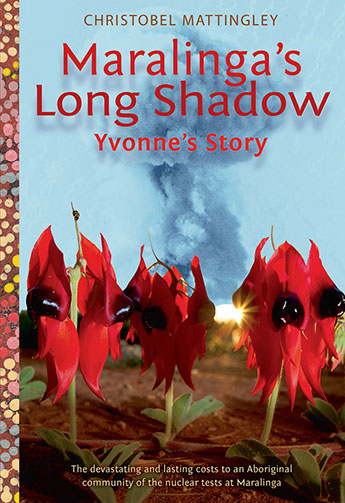Judges for the New South Wales Young People’s History Prize, awarded to ‘Maralinga's Long Shadow: Yvonne's Story’, succinctly captured the impact of this true story. The following comes from the Judges’ comments. ‘On 24 June 1952, the Aṉangu people were forcibly dislocated from the Ooldea Lutheran mission on their traditional land in South Australia and sent to Yalata, another mission station in the country of another Aboriginal people. The traditional Aṉangu country was renamed ‘Maralinga’ and handed over to British scientists to carry out nuclear tests which would contaminate the land for the next 24,000 years.’
‘Maralinga's Long Shadow: Yvonne's Story’ nonfiction text covers 17 gripping chapters of storytelling for its reader. Documenting the life of talented artist and significant community leader of the Anangu people, Yvonne Edwards, the authenticity of her voice permeates all aspects of the writing. Structured in a chronological way, expert writer Mattingley presents a journey ‘Before Maralinga’ (Chapter 1) to a farewell and impact ‘Too Young to Die’ (Chapter 17). As the chapters change, so does Yvonne, whose life is so intimately captured in a breathtaking way. Sensitive anecdotes such as the dingo pup dying in chapter 8, ‘Marriage and Maralinga’ build empathy as the awareness and perspective around atomic testing shows its impact: ‘Nobody over 60 now.’ (p.67, Chapter 8).
Yvonne’s authentic character representation by Mattingley emphasises courage and selflessness, ideals sustained throughout the discussion around the traditional people group of Anangu. The personal narrative of the devastating impact of Maralinga’s nuclear tests of the 1950s is mirrored in a wider familial/cultural story, which alludes to the power of the narrative. Yvonne’s story is one of many. Mattingley is meticulous in sharing Yvonne’s story in a sensitive and respectful way, and this is clear from the language choices used, a strength of the book. The author effectively emphasises the powerful and positive legacy left by Yvonne Edwards in the Ananguu and wider Australian community, and her contributions and courage documented over some 208 pages are an inspiring read.
The compilation of various images throughout the text also enhances the power of Yvonne's narrative told by Mattingley. The ornate details of selected artworks by Yvonne showcase the extraordinary talents of this visionary leader. In particular, it is the rich and vivid colours that Yvonne has chosen in her connection with the Anangu community. The inclusion of some photographs throughout the text also develops the reader's connection with the content covered, as the reminder of real places and faces ringing true well after the text has been put down.

